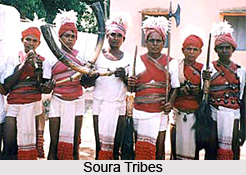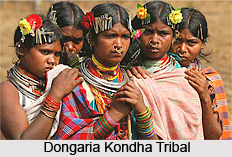 Rayagada district is an ideal abode for the tribal communities who have settled here peacefully. It had a total population of 832019, and amongst them, 473379 belong to tribal communities. With this fact in mind, all the eleven blocks of this particular district have been integrated into tribal sub-plan. Out of it, three micro projects operate for these native tribes of Rayagada who are illiterates.
Rayagada district is an ideal abode for the tribal communities who have settled here peacefully. It had a total population of 832019, and amongst them, 473379 belong to tribal communities. With this fact in mind, all the eleven blocks of this particular district have been integrated into tribal sub-plan. Out of it, three micro projects operate for these native tribes of Rayagada who are illiterates.
Experts also have cited the reason for the huge concentration of theses tribal populace in Rayagada itself. Rayagada`s topography was such that the tribes of Rayagada could mention their age-old ethnicity and cultural identification. Rayagada constitutes of 4785.36 Sq.K.M. with 777.27 Sq.K.M remaining under reserved forest area. However, as a recent phenomenon, tribes of Rayagada along with their sub tribal communities witness development. Rate of development however, depends on the way they assimilate other contemporary communities.
In the district, the kondhas and its subsection is the principal tribal community who comprises the maximum of the tribal population of the district. The second highest are the Souras. As far as education is concerned, both Kondhas and Souras tribes of Rayagada district have shown fewer propensities to education and learning. In spite of their accessibility to developmental process these two tribal communities, specially, have succeeded in retaining their tribal and ethnical identity to a great extent.
Apart from these two tribal communities, few more tribal communities reside. Although they are negligible in number these tribes of Rayagada rightly have made the culture of the district divergent and exotic.
The Kondhas are one of the ancient tribes who inhabit almost in all the blocks of the district. However they are hugely concentrated in various blocks of the district like Kashipur, Rayagada, Kalyansinghpur, Bissamcuttack and Muniguda. They fall into the racial group of Proto-Australoids and are known for their practice of sacrificing human beings during British era. For carrying conversation they converse in a distinctive language, known as "Kui". No written script is available. They are land dwellers and also rightly gel with the forest condition.
As has been mentioned earlier, Kondhas further can be divided into sub groups. Dongaria Kondha tribal community is the ancient most sub tribal group. They reside in the plateaus of Niyamgiri hill ranges, which encircle the areas of Rayagada and Koraput and Kalahandi districts. Huge concentration is found in Kalyansinghpur, Bissamcuttack and Muniguda blocks. They are known as Dongaria, which signifies dweller of "donger". In Oriya language dongar means hill. In the whole of the Orissa state of India they have been declared to be one of the thirteen primitive tribes.
 Two Dongaria Development Agencies (DKDAs) operated in 2 blocks for the overall growth of tribal communities. Their motive was to improve pre agricultural economy and low literacy scenario. For sustaining their livelihood, they have adapted to various occupations like foraging, hunting and gathering. Nowadays, they have developed dependence on shifting cultivation, also known as Podu or slash and burn cultivation.
Two Dongaria Development Agencies (DKDAs) operated in 2 blocks for the overall growth of tribal communities. Their motive was to improve pre agricultural economy and low literacy scenario. For sustaining their livelihood, they have adapted to various occupations like foraging, hunting and gathering. Nowadays, they have developed dependence on shifting cultivation, also known as Podu or slash and burn cultivation.
Next in tandem is the Souras , also known as Lanjia Souras . They have developed the style of wearing a loin dress which hangs from behind and can be easily mistaken it for a tail. Because of their unique style of dressing they have been named so. They reside in various blocks like Padmapur Gunupur, and Gudari. They are mainly found in the Puttasingi area, which stretches up to a distance approximately 25 Kms from Gunupur NAC.
People identify them in various names like "Savara", "Sabara", "Sora". They belong to Proto Australoid group. Their main concentration is on Gunupur, which lies adjacent to several blocks like Gumma, Serango of Gajapati district. This tribal community has developed their own dialect. However, Soura tribes do not follow written language. Majority of people have taken up to shifting cultivation. Only a handful of people are practicing `settled agriculture`. They also practiced terraced cultivation. Crops like cereal and pulses are grown.
Tribal society also follows unique norms and practices. Family structure of these tribes of Rayagada is nuclear. However a handful of extended families known as Birinda also are predominant. Birinda comprises of all the successors of a common ascendant of 4 to 5 generations.
Their ritual of marriage also is quite significant. Three types of marriage are in vogue. These include marriage by elopement, bride capturing and also by negotiation. The last one is considered to be apt and ideal. It is quite expensive. Clan system is absent. Polygamy is prevalent. In a house, economy centers on the woman. She works very hard and also assists her husband in various works like plowing and reaping crops and also managing domestic activities.
Soura tribes of Rayagada are pious and practice religious practices, which are very intricate and deep-seated. Polytheism is dominant. They have developed beliefs in a myriad of deities and hereditary spirits.
Their artistic acumen is far-famed for wall paintings. These paintings are called Edital. Dance and music is an integral part of the lives of these tribes of Rayagada. Out of fear of being afflicted by any kind of personal harms and threats, these tribes of Rayagada follow certain laws, rituals and thus appease the deities.
Soura tribes of Rayagada fete quite a number of festivals. There are wide ranging starting from family occasions like those related to birth and girls attaining puberty. Several harvesting festivals are held in celebration of good sowing. Whole of the community gets involved into the celebration of these festivals. There is a unique feature of these festivals. Those are the days when these Soura tribes consume alcohols like Mahua and Handia. The mood gets frenzied with dancing and singing continuing through out the night. Animal also is sacrificed for pleasing the deities especially the harmful ones.
The way the political institutions of Soura tribes of Rayagada are formed too is significant. In each and every village and region, a conventional political association is formed with few hereditary posts. For instance, Gomango is the secular headman. The person who used to lead the religion is called Buyya. Other people like Mondal , Barik and Raito are the messengers who perform various functions of a traditional court of law.
They first listen to both sides and then impart punishments accordingly.



















